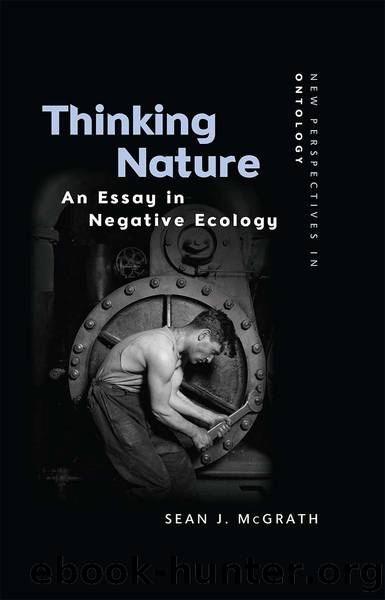Thinking Nature by Sean J. McGrath;

Author:Sean J. McGrath;
Language: eng
Format: epub
Publisher: Edinburgh University Press
Chapter 6
The Human Difference
To return to the Cassirerian line: a word signals, we recall, by pointing directly to the thing or state of affairs it represents, in the past, in the immediate present or in the future; a word symbolises, on the other hand, by virtue of its trans-contextuality. The difference between signals and symbols is not a difference in degree but a difference in kind, and it corresponds to a qualitative distinction between human and non-human thought. All thinking is sustained by signs, but some thinking, human thinking, deploys signs not merely to communicate, but also to conceive.
If one has learned to use words not merely as mechanical signs or signals but as an entirely new instrument of thought ⦠a new horizon is opened up. The principle of symbolization, with its universality, validity and general applicability is the magic Word, the Open Sesame, giving access to the specifically human world, to the world of human culture. (Cassirer, cited in Hamburg 1956: 133â4)1
Cassirer is not advancing a version of ârepresentationalismâ here: symbols do not ârepresentâ an independent reality, merely standing for that which is already logically differentiated; rather, symbols present reality as such, differentiate it and establish relations among the differentiae, thereby rendering it a human reality. âSymbolic forms are not indications, announcements, but âorgansâ of reality since it is solely by their agency that anything real becomes an object for intellectual apprehension and as such is made visible to usâ (Cassirer, cited in Hamburg 1956: 119).
At this point, I will stand accused of speciesism. We are just animals, it will be said, no different and no better than cattle in the field, or jellyfish in the sea. If it is replied that this levelling reduction does no more justice to the distinctively bovine or jellyfish worlds than it does to the human world, the answer will come back: and how do you know what goes on there? How do you know that the jellyfish does not use symbols? I reply, I do not know because I do not know how it thinks at all; I only know how humans think, and that is symbolically. I discern sign usage in the other animals, as in the human animal, but find no indication of symbolisation. That is, I find notably absent in the non-human environments the distinctive marks of symbolisation: art, science and religion.
One might ask if the pervasive underselling of reflection and human freedom among eco-critics â the denial of the human difference â creates more problems than it solves. The nineteenth-century assertion of the ideality of the human subject (the Scholastics spoke of âthe immateriality of the soulâ), its unique capacity for moral responsibility, did not always result in aestheticisation, objectivisation and exploitation. We must be careful not to distort the truth in the interest of eco-politics: granted that the aestheticisation and objectification of nature â as something out there, over there, for our enjoyment, of use-value only (without spirit, et cetera) â is at the root of
Download
This site does not store any files on its server. We only index and link to content provided by other sites. Please contact the content providers to delete copyright contents if any and email us, we'll remove relevant links or contents immediately.
Phoenicians among Others: Why Migrants Mattered in the Ancient Mediterranean by Denise Demetriou(564)
Verus Israel: Study of the Relations Between Christians and Jews in the Roman Empire, AD 135-425 by Marcel Simon(562)
Caesar Rules: The Emperor in the Changing Roman World (c. 50 BC â AD 565) by Olivier Hekster(542)
Europe, Strategy and Armed Forces by Sven Biscop Jo Coelmont(487)
Give Me Liberty, Seventh Edition by Foner Eric & DuVal Kathleen & McGirr Lisa(457)
Banned in the U.S.A. : A Reference Guide to Book Censorship in Schools and Public Libraries by Herbert N. Foerstel(457)
Reading Colonial Japan by Mason Michele;Lee Helen;(447)
american english file 1 student book 3rd edition by Unknown(447)
The Roman World 44 BC-AD 180 by Martin Goodman(444)
DS001-THE MAN OF BRONZE by J.R.A(432)
The Dangerous Life and Ideas of Diogenes the Cynic by Jean-Manuel Roubineau(423)
Basic japanese A grammar and workbook by Unknown(420)
The Oxford History of World War II by Richard Overy(419)
Introducing Christian Ethics by Samuel Wells and Ben Quash with Rebekah Eklund(419)
Imperial Rome AD 193 - 284 by Ando Clifford(418)
Literary Mathematics by Michael Gavin;(379)
Language Hacking Mandarin by Benny Lewis & Dr. Licheng Gu(356)
How to Reach the 9.0 in IELTS Academic Reading by IELTS Medical(340)
The Oxford History of the Renaissance by Campbell Gordon;(337)
